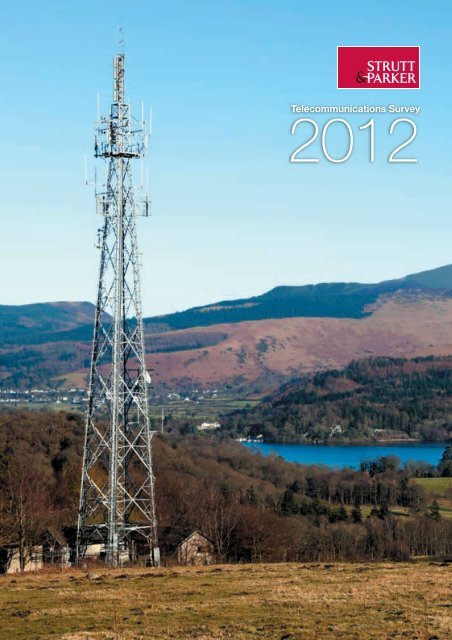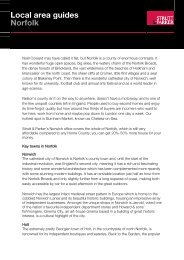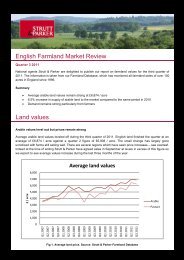Download PDF - Strutt & Parker
Download PDF - Strutt & Parker
Download PDF - Strutt & Parker
- No tags were found...
Create successful ePaper yourself
Turn your PDF publications into a flip-book with our unique Google optimized e-Paper software.
Telecommunications Survey2012
WelcomeOnce again, I am delighted tointroduce <strong>Strutt</strong> & <strong>Parker</strong>’sTelecommunications Survey.This year we have surveyedover 4,800 telecoms sites and whilst theindustry has moved on apace since our lastsurvey, the severe rent reductions quoted bytelecoms operators is not borne out in theanalysis of our database.Despite pressure on rents from the operators,there remain significant black spots, or ‘notspots’, and capacity constraints acrossnetworks. As demand inevitably increases fordownloading data and as handsets offergreater facilities and functionality, thepressure will increase on networks unless thetechnology and spectrum capacity can keeppace. We predict a greater demand for siteswith the move to 4G, just as we had with 3Gand 2G.There are aggressive shifts taking place in themarket but our pedigree as telecomsspecialists enables us to work technical andimaginative solutions in favour of our clientsfor individual sites or for extensive portfolios.Robert PaulHead of <strong>Strutt</strong> & <strong>Parker</strong>’s Telecoms GroupTelecommunications Survey20123 Background &Technology4 Greenfield SitesRooftop Rents5 Arbitration6 Lease TermsSite SharingDecommissioning7 New Roll OutFibre OpticsThe Courts8 Contact Us© Image Copyright istockphoto.com
Background & TechnologyMobile telephony is a vital part of the UK economy. According to Ofcom, in 2008 86% of adults owned amobile phone; that figure now stands at 91% and there are approximately 1.3 mobile phones per head ofpopulation.Mobile operators’ retail revenues are in excess of £15 billion per annum. Mobile voice call minutes are inexcess of 125 billion minutes per annum and now account for half of the total voice call minutes in the UK.At the end of 2010, 15% of all adults lived in homes with a mobile phone and no landline; in 2006 it was only4%. Whilst the average mobile connection has increased to 1.3 per person, the number of fixed lines ‘landlines’ fell yet again to 33.4million.Across the UK, 96% of people now live in postcode districts with at least 90% 2G coverage from one or moreoperators. This figure increases to 99% in England but is lower in Wales, Scotland and Northern Irelandreflecting lower population densities and terrain limitations. 3G coverage is relatively similar.The smartphone has taken off. In the two years to March 2010 the number of people in the UK accessing theinternet from mobile devices more than doubled. At the end of 2010 there were 33.1 million 3G mobileconnections, 6.2 million more than in 2009. Now over 4.8 million people access mobile broadband via alaptop and dongle and half of the population own a smartphone. The increasing use of mobile broadbandservices via these devices resulted in a 67% increase in data transferred over the UK’s mobile networks in2010. Smartphones require a denser pattern of radio masts and therefore a greater capital investment.Last year the government announced a £150 million cash injection to fill the aptly named ‘not spots’.Allocation of this funding is expected to include the development of new broadband carrying telecomsinfrastructure in areas of little or no existing service. Additionally, Ofcom has outlined an ambitious proposal toextend 4G coverage to at least 98% of the population. Furthermore, the emerging 4G technology promisessignificantly faster wireless broadband services with speeds being up to 230% faster than the currentnetworks and expected to become 450% faster by 2020.Notwithstanding this growth, operators are feeling the pinch. New proposals from Ofcom for a 37% cut inconsumer charges in real terms over 4 years will affect operators’ future revenue. UK margins remain belowthe level that operators enjoy elsewhere in the EU.According to the Mobile Operators Association (and notwithstanding the decommissioning of some sites) thenumber of sites across the UK rose to 52,500 in 2010 from 51,300 base stations at the start of 2009 (up from48,000 at the end of 2006). Two-thirds of these are installed on existing buildings or structures.Operators are increasingly working in conjunction with each other. The first such successful collaborationarose in December 2007 with a joint venture between H3G and T-Mobile who, under Mobile BroadbandNetwork Ltd (MBNL), consolidated their networks combining hardware and infrastructure to operate a singlenetwork under joint names.In July 2010 T-Mobile formed a joint venture with Orange. T-Mobile (company no 023821610) renamed itselfEverything Everywhere Ltd. Orange remained a seperate legal entity (company number 021781917) and isowned by the former T-Mobile company through an offshore holding company.In 2009 O2 and Vodafone established a joint team called Cornerstone to share structures and consolidatenetworks. As a consequence, O2 and Vodafone work closely together.This has resulted in there being effectively two, rather than five organisations, operating, planning and buildingmobile telephone networks across the UK.3STRUTT & PARKERTELECOMMUNICATIONS SURVEY 2012
Greenfield SitesIn past months all the operators have been writing to landowners in an effort to reduce rentals, arguing thatthere has been a substantial shift in the market due to network consolidation and threatening to moveelsewhere unless concessions are made.Our Survey of over 4,800 sitesfound little substantivejustification for claims thatrents have fallen to the extentclaimed, but revealed that therehas been a drop in averagerentals reported in recent yearsfrom the peak in 2009 as aconsequence of such pressure.£ P.A.6000500040003000200010000Average rents for masts up to 15m2000 2001 2002 2003 2004 2005 2006 2007 2008 2009 2010 2011Height remains a factor in rentdetermination and appears tobe becoming more marked asthe difference between our lastanalysis (grey) and our 2012survey (red) reveals.Rooftop RentsRooftop rents remain relatively strong.9000800070006000500040003000200010000Average rents by heightMasts up to 15m 16-20 metres 21-30 metres >30 metresRooftop rents in central Londonare in the order of £20,000p.a.,whilst in other major cities,installations for 6 or more antennaeare in the order of £14,000p.a.istockphoto.com14000120001000080006000400020000Average rents for rooftop sites2000 2001 2002 2003 2004 2005 2006 2007 2008 2009 2010 2011STRUTT & PARKERTELECOMMUNICATIONS SURVEY 2012 4
ArbitrationIt is clear that only transactions falling within certain parameters set by the operators are being readily agreed.There are a considerable number of reviews outstanding. The validity of such guidelines is questionable givenanalysis of one operator’s guidelines as against the market:-Rural2010 GuidelinesPopulation100,000CityDatabase(all locations)2009-2012Greenfield SitesPole with compound =49m2£3,500 £5,057£4,250 £5,846RooftopType 1 3
Lease TermsOperators appear to be resisting many of the terms previously agreed as the norm.The survey reveals that review periods are fairly evenly balanced between three year and five year reviewpatterns, despite the operators’ preference for the latter.Five years ago, operators soughtRPI reviews. They now seek OpenMarket Value as the only reviewmechanism. Our analysis of newlettings over the past 5 years revealsOMV / RPI reviews remain theusual mechanism for review.Review Mechanism29%50%21%OMVRPIOMV/RPISite SharingSite sharing remains a live issue in the marketplace with operators trying to obtain advantageous terms toshare between themselves and reduce any payaway to landlords.Analysis of new leases agreed overthe past 5 years reveals that asubstantial proportion ofagreements (30%) prohibit sitesharing or restrict third partyoccupation to group companies.Payaway provision2% 4%30%10%12%42%Fixed sums30% payawayProhibitedIncludedWhere site sharing rights have been granted this is normally dealt with by a payaway based on a percentageof the site share income, but an increasing number of transactions have fixed sums.Our survey reveals a three year average income to the tenant of £8,054.12 per sharer and an average returnto the landlord of £2,725.32 by means of payaway. Where fixed sums have been agreed the averagepayment is £2,200 per operator. To put this into perspective Vodafone and O2, under Cornerstone, will onlyoffer 30% of the sum that they actually charge each other (50% of the base rent), which equates to 15% ofthe base rent giving a landlord only about £750 for the additional operator.DecommissioningOur 2010 Survey highlighted some of the issues surrounding decommissioning. This survey finds that relativelyfew of the threats for decommissioning have actually been carried through, but of these, there are many caseswhere the operator has relied on a break clause which refers to ‘environmental changes’ whereas the decisionto terminate the lease is in fact based upon commercial factors and the availability of a cheaper site sharenearby. Challenges have proved successful in some cases and led to negotiated settlements.Where operators have elected to ‘abandon’ sites rather than to decommission them and reinstate, one-offpayments to landowners have averaged approximately £4,500 but have ranged to anything up to £12,000.Surrender agreements have also included indemnities for landowners against rating and planning enforcementaction as well as payment of legal and professional fees.STRUTT & PARKERTELECOMMUNICATIONS SURVEY 2012 6
New Roll OutWith Ofcom statistics already showing increases in the number of base stations across the UK, there isanecdotal evidence that significant numbers of additional sites will be required. Undoubtedly, many newinstallations will share existing towers, roof-top sites and even antennas, but inevitably the need to reduce thesize of cells to deal with capacity will require new infill sites. This will present opportunities for landlords ofexisting sites who will need to be wary of loosely worded site sharing, subletting and group companyassignment clauses if they are to make the most of such opportunities.The advancement of 4G (using Long Term Evolution technology) is highly likely to depend on an increasednumber of sites and this appeared to be the findings of Telefonica O2 in their recent 4G trial in London.Fibre OpticsWith the demand for greater access to data and for improved communication links between mobile phonemasts, there has been greater activity in relation to fibre optic links. Not all telecommunications leases allowfor fibre optic links to the site and lease wordings need to be considered very carefully as negotiations canyield profitable results for landlords.Whilst new links have featured significantly in the last 2 years, including international links to Ireland and theContinent, lease renewals have become the main area of activity in the fibre optic market. One operator,Energis, rolled out a network along the top of electricity pylons and many of these leases were for fixed termswhich have now expired. It is worth noting that, whilst nationally agreed frameworks may assist landowners,they are not binding and negotiations based on actual market evidence invariably produce a better result.Rents and capital payments can vary depending on the number of fibres and the availability of alternativeroutes. Average capital payments for 15 year fixed terms are at approximately £10 per metre run or £2,000per tower.Virgin Media has already connected cables with the capacity of 100Mbits per second to 4 million homesand BT plan to connect 10 million homes to their 80-100Mbits per second system by 2013, extending this tocover 66% of homes in 2015. This level of activity is bound to have repercussions for the property relatedaspect of the industry.The CourtsSince our last Survey, there have been a number of interesting developments before the Courts.The main legislative framework for telecommunications, The Electronic Communications Code, came in for agreat deal of criticism from Lord Levison in Bridgewater Canal Company –v- Geo Networks [2010] EWHC548 (Ch) who described it as “…possibly one of the worst pieces of legislation on the Statute Book”. Thiscomment went unremarked in the subsequent appeal and, partly as a consequence of these comments, theLaw Commission is to conduct a review of the Code.Network consolidation itself came under scrutiny before the Technology Court in Arqiva –v- EverythingEverywhere Ltd [2011] EWHC 1411 (TCC), where it emerged that Orange no longer has an electroniccommunications licence, it having been transferred to the separate legal entity of Everything EverywhereLimited with effect from 2nd March 2011. The validity of this transfer was queried by the judge but has notbeen fully scrutinised in that the case settled before a second hearing to determine the validity of Ofcom’sactions. This transfer may give rise to issues under the business occupancy provisions at lease renewal underthe Landlord & Tenant Legislation and in the exercise of Code Powers. It would appear doubtful that Orangewill be entitled to serve a counter notice under paragraph 21 of the Code to any notice to quit.7STRUTT & PARKERTELECOMMUNICATIONS SURVEY 2012
Contact DetailsNorth West, West Midlands and WalesRobert Paul01743 284205robert.paul@struttandparker.comNorth EastDavid Barrett01609 788453david.barrett@struttandparker.comSouth WestAmy Thompson01722 344024amy.thompson@struttandparker.comScotlandIan Thornton-Kemsley01330 826813ian.thornton.kemsley@struttandparker.comEast MidlandsJeremy Dawson01780 484044jeremy.dawson@struttandparker.comEast AngliaRobert Baines01245 254624robert.baines@struttandparker.comAbout UsOur Telecommunications Group comprises of 28specialists across the country. This expertise enablesus to offer advice tailored to the needs of our clients,maximising the opportunities that the industrycontinues to offer, whilst avoiding the pitfalls. Our wideand comprehensive understanding of the industryenables us to advise on every aspect of the market.• Rent reviews• Lease renewals• Site sharing and marketing• Multi-site agreements• Management• Sales and acquisitions• Upgrades and re-negotiations• Expert valuation evidence• Decommissioning• Alternative usesSouth EastCharlotte Kershaw01273 407019charlotte.kershaw@struttandparker.comOffices in:Banbury, Banchory, Brighton, Cambridge,Canterbury, Chelmsford, Chester, Chichester,Cirencester, Edinburgh, Exeter, Farnham,Glasgow, Guildford, Harpenden, Harrogate,Haslemere, Horsham, Inverness, Ipswich,Kingussie, Lewes, Ludlow, Market Harborough,Moreton-in-Marsh, Morpeth, Newbury,Northallerton, Norwich, Odiham, Pangbourne,Princes Risborough, Salisbury, Sevenoaks,Shrewsbury, St Albans, Stamford, WinchesterPlus 10 London officesFor full details of our offices please visitstruttandparker.comstruttandparker.comEvery effort has been made to ensure the information provided within this document is fully accurate. However, <strong>Strutt</strong> & <strong>Parker</strong> accept no responsibilityif recipients should act upon any of the information without seeking the appropriate professional advice. Reproduction in whole or in part withoutwritten permission is prohibited. Your name and details may be held on our database unless you instruct us otherwise.© 2012 <strong>Strutt</strong> & <strong>Parker</strong>.















